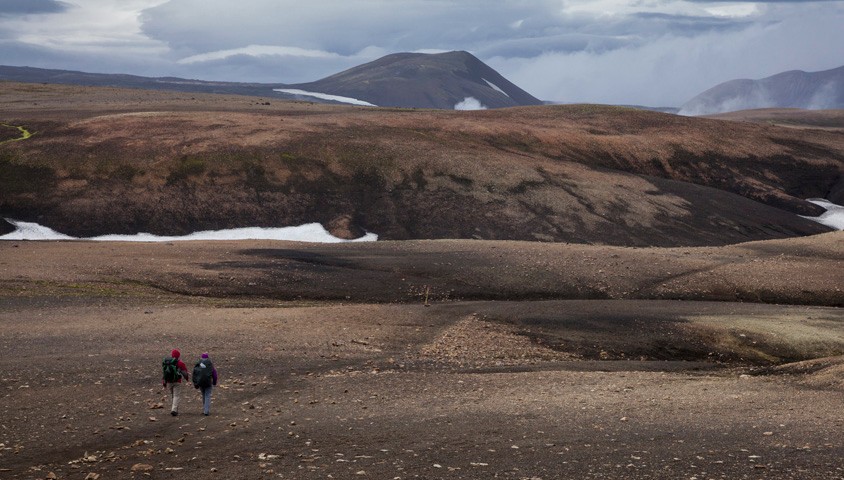At last: a sunlit world. The previous five days on the track have been a swirl of drizzle, rain, fog and stormy skies, even a ‘hurricane’. Now, as the track leads out of the valley, bursts of sun poke through the dispersing cloud and shine warmly on my head. Beside the path, scrub still dripping with overnight rain is set a-sparkling: prostrate junipers and knee-high thickets of stone brambles, ferns and bilberries.
I climb steadily, bursting with the joy of an expanding panorama, making for a pass some 800 metres higher. I’m on the final stage of an 85-kilometre walk through the southern highlands of Iceland. Behind me is the famous Laugavegur trail which connects Landmannalaugur to Þórsmörk. Ahead, the Fimmvörðuháls track crosses the low point separating two sprawling, ice-capped volcanoes before descending to the coast at Skógar.
The track sidles steeply below black domes, pulling away from the highest of the stunted birch trees until it emerges on the tundra ridge-crest. Cloud is lifting off the icecaps, revealing Eyjafjallajökull’s northern icefall: blue, shattered across the jagged ravine of Strakagil, painted in stripes of vivid green moss and bible black, a labyrinth of gulch, pinnacle and crag – terrain that rejects any thought of access. It’s difficult to exaggerate the drama and rich colour palette of Iceland’s landscape, created by volcanic and glacial forces that belittle us humans.
I can’t wait to see more, and stride along the airy ridgeline into the sky.
Just an hour later I’m wondering what the hell I’m doing here, as I duck my head down against the blasting rain and dive into a small gully scoured from deep layers of ash, forced to a freezing halt by the abrupt onset of a North Atlantic storm. Raindrops turn to flicks of snow as I grit my teeth, turn my back to the gale and strip down, adding more layers under my waterproofs. Back on the exposed ridge, a balaclava and cinched-up parka hood are not enough to keep the driven prickles of ice from stinging my face. Gloved hands are turning numb as they work my trekking poles.
Snow turns back to sleet, then rain, and back to snow again, swirling and buffeting me this way and that. My surroundings are intermittently visible – a wasteland of freshly-piled lava in shades of black, occasionally red, all fading into grey. There is no shelter, not one speck of green. It reminds me of a slagheap, so alien yet darkly beautiful, frightening in its intensity and lifelessness.
The lava texture is like froth with the bubbles gone. Any misstep could cause a lot of damage. I focus on placing my feet among the rocks, head down, balancing with my poles, glancing sideways to pick up the next track marker. I can’t keep warm unless I move, fast. I push on as hard as I can. On easy bits I’m almost running, thrusting with the poles. A thought floats to the surface: “maybe I should turn back.”
Then I see a flash of colour. It’s a sign about the 2010 eruption of Eyjafjallajökull. I can only just read the headlines through streaming eyes. So I’m walking across a four-year-old lava field – no wonder the route is so ill formed. But this is good news: it can’t be far to the pass, and the hut. Any thought of a spectacular campsite for my last night has been blown away by the storm. I want that hut…
…The story continues in Wild issue 148, arriving in July. Subscribe today.



